Play ball
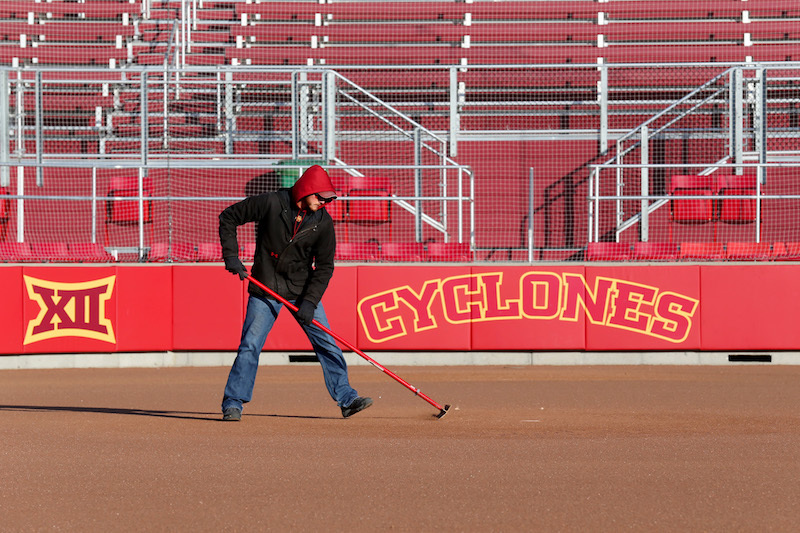
Photo by Christopher Gannon.
Colton Metzger, a horticulture graduate student and graduate assistant working on the athletics turf/grounds crew, prepares the pitching surface on the Iowa State softball field. After spending the first six weeks of the season on the road, the Cyclones take a 15-16 record into their home opener this weekend, hosting Big 12 Conference foe Texas Tech at 4 p.m. on Friday, and noon on Saturday and Sunday. If weather is questionable, schedule updates will be available on the softball website. Admission is free.
Leath takes top job at Auburn University
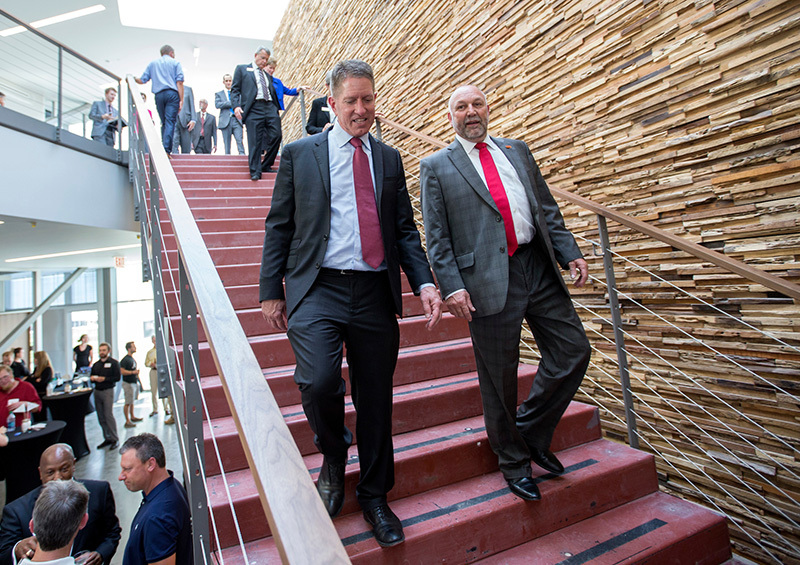
President Steven Leath (right) and regent Bruce Rastetter tour Iowa State's nearly complete Economic Development Core Facility at the ISU Research Park in June 2016. Improvements to the research park are one of the hallmarks of Leath's five-year presidency. Photo by Christopher Gannon.
Auburn University in Alabama named Steven Leath its 19th president on March 20. Leath completed his fifth year as ISU president in January. In his resignation letter to the state Board of Regents, he wrote that his last day at Iowa State will fall between May 8 and June 2.
Senior communications officer for the board Josh Lehman said Wednesday that board members hope to hold a special telephonic meeting within the next week to discuss the presidential transition, including interim leadership.
In a letter to the university community earlier this week, Leath wrote, " I leave with a promise fulfilled, and that was to leave the university better than I inherited it."
Highlights of his leadership years include:
- Student enrollment rose to more than 36,660 students in fall 2016, including 20,713 Iowans, the most at any Iowa university.
- Freshman one-year retention (88.1 percent) and undergraduate six-year graduation (74.1 percent) reached all-time highs last fall.
- The placement rate upon graduation has been 95 percent for the last three years.
- With an eye on bringing down the student-faculty ratio, Iowa State hired nearly 450 tenured or tenure-track faculty over five years.
- Last fall, the ISU Foundation launched the public portion of a $1.1 billion fundraising campaign, the university's largest. More than $550 million -- including $200 million alone in student scholarships -- was raised in the quiet phase of the campaign.
- The average debt for ISU students graduating with debt has dropped 6.8 percent since 2012.
- The university's technology transfer and economic development functions are now housed under one roof in the ISU Research Park for greater effectiveness and efficiency.
- Land size of the ISU Research Park has more than doubled (to 400 acres). The park also serves as the northern gateway to the Cultivation Corridor, which Leath co-founded to establish central Iowa as a global center for innovation in agbiosciences, biorenewables and advanced manufacturing.
- Research funding in FY16 hit a record $252.5 million.
- A renewed emphasis on faculty recognition resulted in four faculty members' election to national academies in the past two years.
- Efforts to improve the campus climate included creation of a vice president for diversity and inclusion post, revival of the 2005 Principles of Community and the recent announcement of a campus climate survey scheduled for fall.
The Iowa State campus also has physically changed during Leath's administration. Renovations were completed in Marston Hall, the north end of Lagomarcino Hall for the School of Education and the power plant. New buildings include:
- Geoffroy residence hall
- Biosciences projects: Addition to Bessey Hall and Advanced Teaching and Research Building
- Hansen Agriculture Student Learning Center
- Economic Development Core Facility in the research park
- Sukup and Elings halls
- Jack Trice Stadium's south end project and adjacent plaza
- ISU lease of one floor of the Kingland Building in Campustown
- Campanile wall
- Student Innovation Center, for which construction begins this summer. Leath helped secure $40 million in state funding for the project
ISU leaders currently are seeking a multiyear $100 million state commitment from the 2017 Legislature to replace the Veterinary Diagnostic Laboratory.
Suchan tapped as interim registrar
Senior associate registrar Jennifer Suchan was named interim registrar, succeeding Laura Doering, who was named associate vice president for enrollment management and student success last month. Both appointments took effect on March 20. A search for the next registrar is planned for next fall.
As interim registrar, Suchan will manage a staff of approximately 35. Her responsibilities will include strategic planning, budgeting, developing and implementing university policies, compiling data and reports, and serving as a member of the student affairs cabinet.
"I'm extremely pleased and grateful that Jennifer has agreed to serve as interim registrar," Doering said. "She is a service-oriented, action-driven and caring leader who will provide excellent direction for the office."
Suchan, who has served as senior associate registrar since 2015, was assistant registrar at Northern Iowa (2010-15) prior to her appointment at Iowa State. She earned bachelor's (psychology) and master's (postsecondary education, student affairs) degrees from UNI, and a doctorate (education) from Iowa State.
"I am thankful to be surrounded by a very talented team of individuals who are deeply passionate, committed and capable," Suchan said. "I am eager to collaborate with campus partners to continue implementing and advancing the great work that we do here on campus to prepare students for academic and professional success."
Math faculty examine numbers to improve student learning
About five years ago, professors in Iowa State's math department were tackling several challenges:
- D-fail-drop (DFX) rates in precalculus were up to 65 percent
- 30 to 45 percent of precalculus students passed
- 60 percent of calculus students regularly attended class
Today, after some tweaking, collaboration and old-fashioned hard work, those less-than-enviable numbers have turned into points of pride for Iowa State's math department:
- DFX rates in precalculus have dropped to about 25 percent
- 75 to 80 percent of precalculus students pass
- Up to 90 percent of calculus students (in team-based learning sections) regularly attend class
The problem
When associate professor of mathematics Tim McNicholl joined the ISU faculty in fall 2012, he was tasked with figuring out how to help more students pass precalculus. He and other faculty members worked to pinpoint the problem, which led to an interesting discovery: Of the 1,000 students enrolled in precalculus at the time, one-third were upper-level design and architecture majors who needed the class to satisfy a credit for their majors. The remaining students were freshmen science, technology, engineering and math (STEM) majors, who needed to pass the class to continue in their chosen fields.
"We were dealing with two very different populations," McNicholl said.
The solutions
Immediately, McNicholl and the other precalculus instructors made small, but not insignificant, changes to the class: better coordination between class sections, common assignments and exams, and less material.
"The DFX rate dropped to 35 percent that semester, just with those changes," McNicholl said.
Shortly thereafter, the math department dissolved the original precalculus class (Math 142) and created a calculus prep class for STEM majors (Math 143), and an applied trigonometry course for design and architecture students (Math 145). In addition, instructors implemented the Pathways to Calculus curriculum in Math 143, developed at Arizona State University after years of research into what students need to be successful in calculus and continue in advanced math courses.
All about the numbers
As part of the Pathways curriculum, ISU precalculus students take the Precalculus Concept Assessment test at the beginning and end of the semester to determine how they've progressed. Initially, most students score about 7 out of 25 points. By the end of the semester, those scores typically improve to about 14 out of 25. According to Pathways research, student success in calculus is indicated by a score of at least 13 out of 25.
"We have a shortage of STEM workers in the country, and the more people we get through precalculus and calculus, the more students we get through the STEM pipeline," McNicholl said.
On to calculus
Over the past few years, professor of mathematics Elgin Johnston and senior lecturer of mathematics Heather Bolles have transformed their calculus sections for greater student success using team-based learning (TBL).
What is TBL?
TBL is a form of active and small-group learning that can be implemented in a large classroom. It requires students to do assignments before class in order to inspire more engaging classroom discussions. During class, students work on significant team projects, applying calculus concepts. With support from a Howard Hughes Medical Institute grant, Johnston and Bolles, with input from faculty in science and engineering, have spent years developing and refining their TBL materials.
Johnston and Bolles assign their students readings, videos and a quiz prior to class. When class convenes, students work in their assigned groups of five to seven individuals, and take the quiz again.
"They almost always do better after the team quiz," Johnston said.
Greater student success
Bolles said one of the positive outcomes of TBL is that more students physically come to class.
"We've had significantly higher attendance rates," Bolles said. "We had rates as low as 60 percent before the TBL implementation, and now we're at 85 to 90 percent."
Johnston attributes the increased participation to students feeling accountable to their teams.
"Some teams get very close by the end of the semester," he said.
Like McNicholl, Johnston and Bolles measure students' calculus knowledge at the beginning and end of the semester. What they've found is that the students in TBL sections score higher than students in non-TBL classes. In addition, TBL students earn higher scores, on average, on the departmental midterm and final exams.
"TBL lets students be actively engaged in the classroom, and their learning is better for it," Johnston said.
Campus energy is cleaner
Last spring, utility services completed a three-year project to replace three of its five coal-fueled boilers with natural gas boilers. The change cut the power plant's coal consumption nearly in half -- to about 75,000 tons annually. Even so, coal remains the single largest fuel source for campus energy production, as the following table shows.
|
Energy source |
FY16 (percent) |
FY12 (percent) |
|
Coal |
63 |
92 |
|
Natural gas |
28 |
2* |
|
Wind |
1.5 |
1.5 |
|
Purchased electricity |
7.5 |
4.5 |
|
Total |
100 |
100 |
*Partial year for first on-site boilers at Vet Med campus
Diversity in its fuel array is an important strategy at Iowa State, said utilities project engineer Lindsey Wanderscheid, and has its roots in a 2010 study that considered lots of possibilities. Fluctuations in fuel prices and availability drive decisions now about which boilers to use. Typically, two natural gas and one coal boiler are operating, with a second coal boiler used in the winter months. Ultimately, the goal is to keep the rates charged to campus users as level as possible, she said.
Natural gas burns more efficiently and with fewer emissions than coal, but its price historically is less stable than coal.
"We have much more flexibility now," Wanderscheid said. "If natural gas prices get out of whack, we could burn more coal to minimize campus rates."
The five boilers connect to existing steam, water and electrical systems in the power plant which produce steam (heat), electricity and chilled water (cooling) for the campus.
Cleaner energy
Wanderscheid said power plant emissions -- gases and particles -- are down by about 80 percent since the natural gas boilers went online. Iowa State also removes 28 percent less ash (a coal-burning byproduct) from campus now than it did four years ago. And despite perceptions about air pollution, she said Iowa State's two remaining coal boilers are among the cleanest of their kind and still have 15-20 years of use in them.
The utility service team routinely investigates alternative fuel options. She referenced a 2010 experiment in which Iowa State burned wood chips with coal in a 15 percent mix for several months and then obtained a state permit to burn that blend. However, high transportation costs for wood chips has prevented Iowa State from using that fuel source yet.
"When we're looking at alternative energy options, the fuel source has to be predictable and reliable or the state won't permit us to burn it," Wanderscheid said.
She said Iowa State and city of Ames representatives currently are studying possibilities for purchasing solar-generated electricity from a third party.
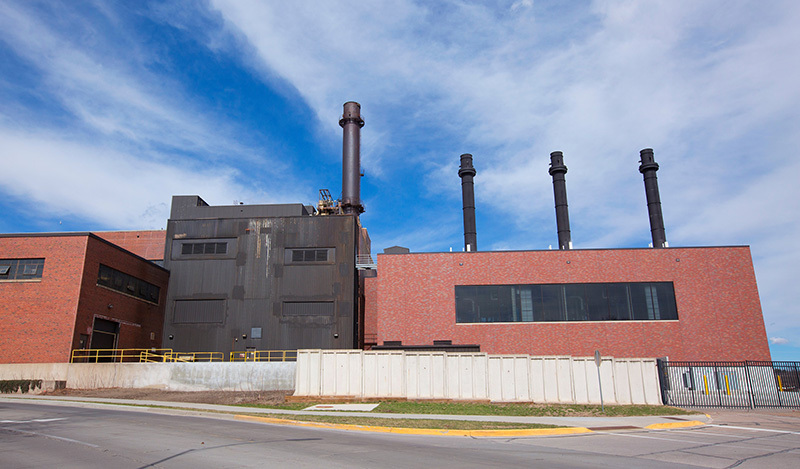
Photo by Christopher Gannon.
The March 2017 view (above) of the power plant includes less ash-handling structure and a new brick building (right) that houses three natural gas boilers. Pictured below is the same view of the power plant in November 2012, prior to the start of the boiler replacement project.
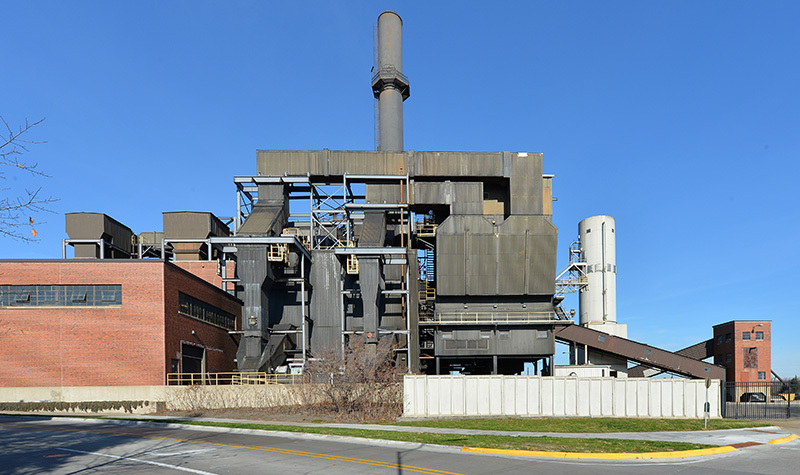
File photo by Bob Elbert.
Lynda.com offers convenient professional development
Professional development doesn't have to be time consuming or expensive, and it's possible to receive comprehensive training without ever leaving your desk.
Iowa State faculty, staff and students have unlimited access to Lynda.com, a training website that offers thousands of instructional videos and tutorials developed by experts in various industries. Iowa State pays for the website's annual fees, allowing the campus community to access the site at no personal cost. To log on, users must access Lynda.com through the Iowa State website (under Sign-Ons) using their Iowa State Net-ID and password.
Expect the unexpected
Topics run the gamut. Of course, there are scores of technology tutorials that teach the basics of Microsoft Word, Excel and the like. There also are thousands of videos that can help employees learn about management principles, meeting facilitation, web development, blogging, digital marketing, team building and more.
"Lynda.com allows all of us to invest in learning without spending time away from the office," said Carol McDonald, director of university information systems in IT services.
By the numbers
Lynda.com usage across the university has steadily increased over the past few years. Here's a look at some numbers:
- From January 2015 to January 2017, the number of active users increased nearly 75 percent
- From 2015 to 2016, the university's cost per video decreased by 19 percent due to high campus usage
- The number of hours faculty, staff and students spent watching tutorials from 2015 to 2016 rose by 23 percent
The most popular Lynda.com courses for Iowa Staters include:
- Microsoft Project 2016
- Installing and Administering Atlassian JIRA
- HTML Essential Training
- Learning JIRA Software
- Civil 3D Essential Training
- Premiere Pro CC Essential Training (2015)
Limited time? No worries
The time commitment for each tutorial varies from a few minutes to multiple hours. Don't have time to finish a session? No problem. The next time you log in you can pick up where you left off.
"There is tremendous value in having just-in-time training," McDonald said. "Having a resource that's going to provide you with the correct information at your desktop when you need it is a pretty valuable resource to have."
Related stories
- Colleges, ITS fund popular online tutorial site, Sept. 6, 2012
- IT tutorials at your fingertips, June 3, 2010
Letter from Steven and Janet Leath
Dear Cyclones:
I write today to inform the Iowa State Community that I have resigned my position as President of Iowa State University in order to pursue an outstanding opportunity at Auburn University. When first called about this opportunity, I responded truthfully, as I always had done since my arrival in Iowa, by saying, “I love Iowa State, and the Iowa State students, faculty, staff and Cyclone family are wonderful; I am not looking to leave.” However, after much thought, Janet and I decided to look at the opportunity at Auburn and realized the opportunity was one we could not pass up. When we arrived in Ames, we had no idea how much we would fall in love with Iowa and the Cyclone family. In fact, it was not long ago we bought a farm here and expected to retire here. However, we now realize our destiny is in Alabama and leading one of the nation’s great Land-grant universities to even greater prominence.
I leave with a promise fulfilled, and that was to leave the university better than I inherited it. I leave with Iowa State achieving record enrollment, retention rates, graduation rates, job placement rates as well as records in fundraising and research funding, and numerous other metrics. I am proud of the many accomplishments that we achieved in economic development and community engagement.
I have volunteered to work closely with the Regents to identify an interim President and start a search for a permanent President. In addition, I will keep you updated during this time of change.
Janet and I have made lifelong friends here in Iowa and have had many great experiences. We will always consider ourselves Cyclones and have great affection for this university and its beautiful campus; it is a very special place. Our appreciation for the Cyclone family is beyond words, and we found this extended family of students, faculty, staff, alumni and friends to be the greatest joy of our time at Iowa State.
Sincerely,
Steven and Janet A. Leath
President and First Lady
Portrait-painting sessions are open to the public
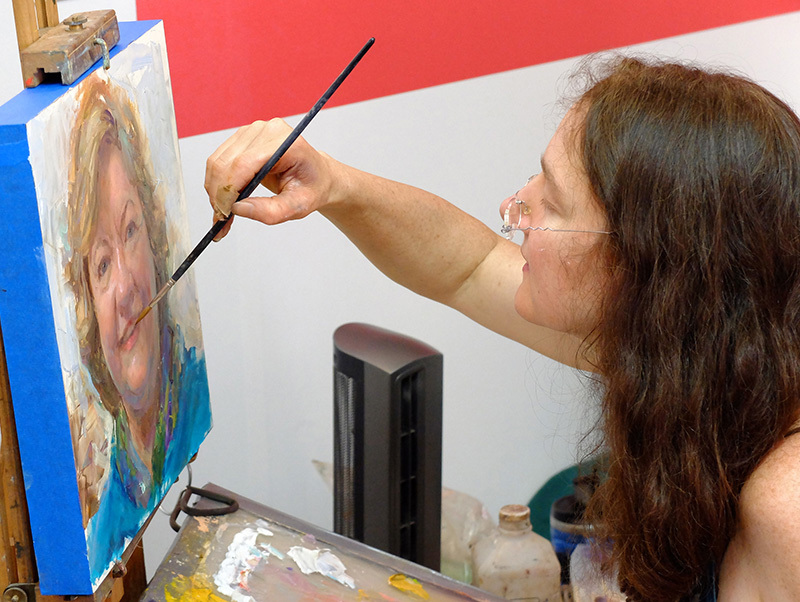
Artist Rose Frantzen puts the finishing touches on a portrait of Marshall County extension council member Mary Giese during the 2016 Iowa State Fair. Photo by Christopher Gannon.
Maquoketa artist Rose Frantzen, who drew state fair goers last August to the Iowa State exhibit where she painted 19 portraits in 11 days, is coming to campus next week to continue her portrait work. During a nine-day residency in the Christian Petersen Art Museum, Morrill Hall, Frantzen will paint the portraits of 13 more Iowa Staters.
"This truly is a feat for an artist to accomplish and an excellent way for students, faculty, staff and the general public to engage with and experience art in the making," said Lynette Pohlman, director and chief curator of University Museums.
Pohlman said Iowa State has a portrait commissioning tradition that stretches back to the 1930s, during the depths of the Great Depression. It was jump-started again in the 1990s, when portraits were commissioned for deans, selected department chairs and accomplished faculty.
"In total, the campus portrait collection celebrates the most accomplished of our campus leaders and preserves their legacies through the fine arts," she said.
All of Frantzen's portrait sitters were identified by University Museums and the ISU colleges as "important and impactful" university alumni, faculty, staff, donors and friends. With two exceptions (past library dean Warren Kuhn and current logistics and support services director Norm Hill), members of the new group of 13 are Iowa State alumni.
Portrait sessions are open to the public in room 3 of Morrill's lower gallery.
Portrait painting schedule
Wednesday, March 29
- 10 a.m.-2 p.m., Warren Kuhn, retired dean of library services (1989)
- 3-7 p.m., Larry Ebbers, retired University Professor in higher education (2016)
Thursday, March 30
- 10 a.m.-2 p.m., Carol Grant, chair of University Museums' curator associates, docent
- 3-7 p.m., George Burnet, retired professor and chair of the chemical engineering department (1995)
Friday, March 31
- 3-7 p.m., Monica Lursen, executive director of the Iowa Academy of Nutrition and Dietetics, Clarksville
Saturday, April 1
- 3-7 p.m., Al Jennings, chief executive officer, board chairman for EFCO concrete forms, Des Moines
Sunday, April 2
- 2-6 p.m., Dave Miller, retired director of facilities planning and management (2017)
Tuesday, April 4
- 10 a.m.-2 p.m., Lori Jacobson, project management and planning consultant to University Museums
- 3-7 p.m., Ed McCracken, retired chief executive officer of Silicon Graphics
Wednesday, April 5
- 10 a.m.-2 p.m., JaneAnn Stout, retired associate dean of the College of Family and Consumer Sciences and director of ISU Extension to Families (2008)
- 3-7 p.m., Mary Jane Hagenson, retired vice president of research and technology for Chevron Phillips Chemical Co.
Thursday, April 6
- 10 a.m.-2 p.m., Norm Hill, director of ISU logistics and support services
- 3-7 p.m., Alicia Carriquiry, Distinguished Professor of statistics
The 32 Frantzen portraits will make up a "Faces of Iowa State" touring exhibition, which will open in August at the Brunnier Art Museum. Following its Brunnier showing, the exhibition will be featured at sites throughout the state. At the conclusion of the tour, the portraits will become part of the university's Art on Campus collection.
Festival pays tribute to women composers
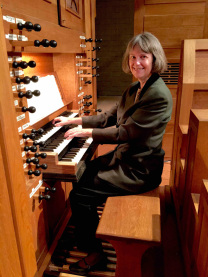
Miriam Zach. Contributed photo.
Music composed by women has not received the respect and recognition it deserves, says Miriam Zach, adjunct assistant professor of music and the Charles and Mary Sukup Endowed Artist in Organ.
In 1997, Zach helped remedy the rebuff by establishing the International Festival of Women Composers. Now in its 21st year, the annual event will be held at Iowa State for the first time on March 24 (7:30 p.m.) and March 26 (3 p.m.), with concerts featuring compositions written only by women. The performances, in Music Hall's Tye Recital Hall, are free and open to the public.
Composers' library
The compositions slated for Sunday's concert all are from the Margaret Zach International Women Composers' Library, established in 1994 in Gainesville, Florida, by ISU music faculty member Miriam Zach. Named in honor of her late mother, the library contains a collection of manuscripts, published scores and books, commercial and private recordings, correspondence, interviews, theses, dissertations and other documents by and about women composers. The library is a private archive, accessible upon request by contacting Zach.
Concert details
Friday's concert will showcase compositions written primarily by Iowa State faculty and students, including two world-premiere performances. Musicians include ISU students and faculty performing as vocalists and instrumentalists. Featured instruments include saxophones, a violin and a harpsichord.
The organ is the centerpiece of Sunday's performance, in which the audience will hear compositions by European and American women composers from the Baroque era through today. Zach is the featured organist and will be accompanied by music faculty members Amy Christensen on oboe and James Bovinette on trumpet.
"The repertoire on March 24 and March 26 was chosen for its diversity and excellence, and to share the creative talent of ISU faculty, students and alumni internationally," Zach said.
Additional information about the festival and its concerts is online.
